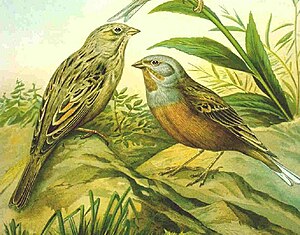Grauortolan
| Grauortolan | ||||||||||||
|---|---|---|---|---|---|---|---|---|---|---|---|---|

Grauortolan ( Emberiza caesia ) |
||||||||||||
| Systematics | ||||||||||||
|
||||||||||||
| Scientific name | ||||||||||||
| Emberiza caesia | ||||||||||||
| Cretzschmar , 1827 |
The Grauortolan ( Emberiza caesia ), also the or the Rostammer , is a species of bird from the family of the Ammern (Emberizidae).
description
The Grauortolan is very similar to the Ortolan ( Emberiza hortulana ). However, it has an unmistakable bright blue-gray head. The throat and the beard are cinnamon brown (not yellow as with the Ortolan), the beak is reddish-pink. The female is more dull and more striped than the male (as with the Ortolan) and can be distinguished from Ortolan females by their cinnamon-brown throat and beard stripe. The Grauortolan juveniles are very difficult to distinguish from the Ortolan juveniles, from the juveniles of the Zippammer you can only tell them apart by the reddish beak. In autumn, the bright colors of males and females are partially obscured. With a length of 16 cm and a weight of about 20 g, the gray ortolan is about the size of a house sparrow .
habitat
The Grauortolan loves stony slopes with scattered bushes and trees as well as semi-deserts. It is a migratory bird and is a summer visitor in Southeast Europe. It breeds all over Greece , in the areas near the Mediterranean in Turkey and Cyprus and in the eastern Mediterranean coastline in Western Asia. He winters in Sudan in Africa. It is rarely seen in the Mediterranean region of Western Europe, and sometimes individual animals get lost as far as Heligoland .
Song and food
The Grauortolan feeds on seeds and insects to feed the young, just like Ammernart. His reputation is a constant "stjip". The singing is similar to that of the Ortolan, but is shorter, something like "dü-dü-dü-düi".
Brood
The nest is built on the ground between stones, often in thick vegetation. It consists of stalks, stems and roots and is padded with hair. The female lays 4–6 off-white to grayish or blackish eggs that are about 19 mm long. It is incubated twice a year. The breeding period is about 12–13 days.
literature
- Peterson, Mountfort, Hollom, “ The birds of Europe - A pocket book for ornithologists and nature lovers about all birds living in Europe ”, Paul Parey Verlag, 10th edition. April 1973, ISBN 3-490-05718-X , pp. 289–290
- Christopher Perrins, "Birds, Biology + Determination + Ecology" , Paul Parey Verlag, ISBN 3-490-22618-6
Web links
- Emberiza caesia in the endangered Red List species the IUCN 2008. Posted by: BirdLife International, 2008. Accessed January 2 of 2009.
- Videos, photos and sound recordings on Emberiza caesia in the Internet Bird Collection
- Feathers of the gray ortolan